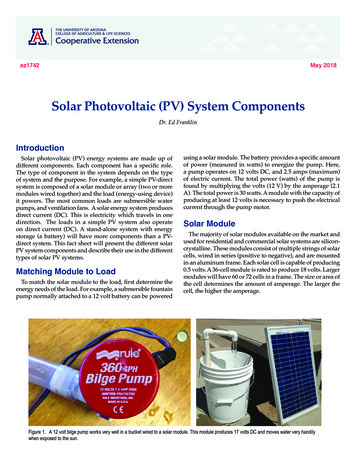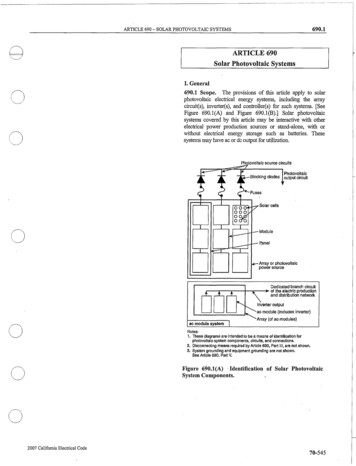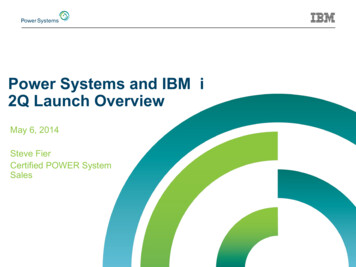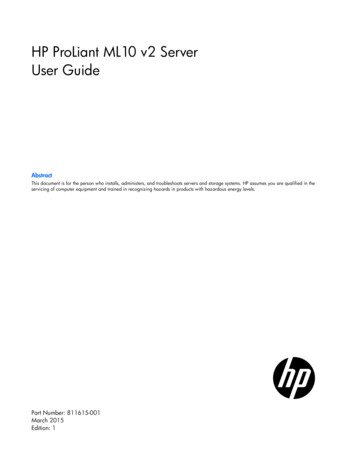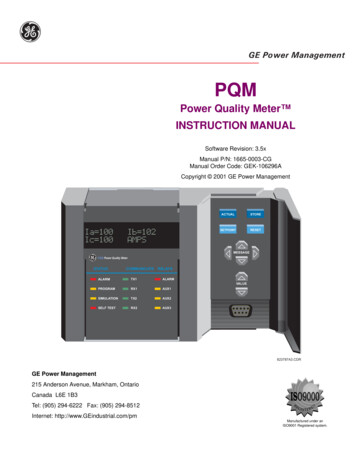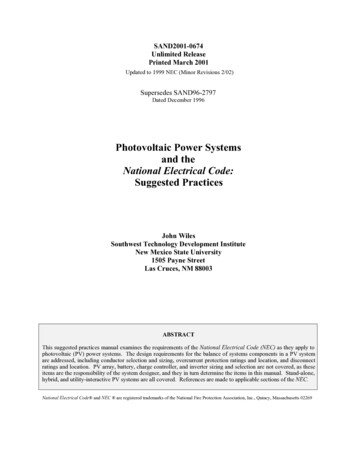
Transcription
SAND2001-0674Unlimited ReleasePrinted March 2001Updated to 1999 NEC (Minor Revisions 2/02)Supersedes SAND96-2797Dated December 1996Photovoltaic Power Systemsand theNational Electrical Code:Suggested PracticesJohn WilesSouthwest Technology Development InstituteNew Mexico State University1505 Payne StreetLas Cruces, NM 88003ABSTRACTThis suggested practices manual examines the requirements of the National Electrical Code (NEC) as they apply tophotovoltaic (PV) power systems. The design requirements for the balance of systems components in a PV systemare addressed, including conductor selection and sizing, overcurrent protection ratings and location, and disconnectratings and location. PV array, battery, charge controller, and inverter sizing and selection are not covered, as theseitems are the responsibility of the system designer, and they in turn determine the items in this manual. Stand-alone,hybrid, and utility-interactive PV systems are all covered. References are made to applicable sections of the NEC.National Electrical Code and NEC are registered trademarks of the National Fire Protection Association, Inc., Quincy, Massachusetts 02269
PHOTOVOLTAIC POWER SYSTEMS and the NATIONAL ELECTRICAL CODEACKNOWLEDGMENTSNumerous persons throughout the photovoltaic industry reviewed the drafts of this manual and provided commentswhich are incorporated in this version. Particular thanks go to Joel Davidson, Mike McGoey and Tim Ball, GeorgePeroni, Bob Nicholson, Mark Ralph and Ward Bower, Steve Willey, Tom Lundtveit, and all those who provideduseful information at seminars on the subject. Appendix E is dedicated to John Stevens and Mike Thomas at SandiaNational Laboratories. Document editing and layout by Ronald Donaghe, Southwest Technology DevelopmentInstitute.TECHNICAL COMMENTS TO:John C. WilesSouthwest Technology Development InstituteNew Mexico State UniversityP.O. Box 30001/Dept. 3 SOLAR1505 Payne StreetLas Cruces, New Mexico 88003-0001Request for copies to Photovoltaic Systems Assistance Center at Sandia National Laboratories505-844-4383PURPOSEThis document is intended to contribute to the wide-spread installation of safe, reliable PV systems that meet therequirements of the National Electrical Code.DISCLAIMERThis guide provides information on how the National Electrical Code (NEC) applies to photovoltaic systems. Theguide is not intended to supplant or replace the NEC; it paraphrases the NEC where it pertains to photovoltaicsystems and should be used with the full text of the NEC. Users of this guide should be thoroughly familiar with theNEC and know the engineering principles and hazards associated with electrical and photovoltaic power systems.The information in this guide is the best available at the time of publication and is believed to be technicallyaccurate. Application of this information and results obtained are the responsibility of the user.In most locations, all electrical wiring including photovoltaic power systems must be accomplished by a licensedelectrician and then inspected by a designated local authority. Some municipalities have additional codes thatsupplement or replace the NEC. The local inspector has the final say on what is acceptable. In some areas,compliance with codes is not required.NATIONAL FIRE PROTECTION ASSOCIATION (NFPA) STATEMENTThe National Electrical Code including the 1999 National Electrical Code is published and updated every threeyears by the National Fire Protection Association (NFPA), Batterymarch Park, Quincy, Massachusetts 02269. TheNational Electrical Code and the term NEC are registered trademarks of the National Fire Protection Associationand may not be used without their permission. Copies of the current edition of the National Electrical Code areavailable from the NFPA at the above address, most electrical supply distributors, and many bookstores.In most locations, all electrical wiring including photovoltaic power systems must be accomplished by a licensedelectrician and then inspected by a designated local authority. Some municipalities have additional codes thatsupplement or replace the NEC. The local inspector has the final say on what is acceptable. In some areas,compliance with codes is not required.iiSUGGESTED PRACTICES
PHOTOVOLTAIC POWER SYSTEMS and the NATIONAL ELECTRICAL CODETable of ContentsSUGGESTED PRACTICES.1Introduction.1Methods of Achieving Objectives.3Scope and Purpose of the NEC .4This Guide.5Photovoltaic Modules .5Module Marking .6Module Interconnections.7Tracking Modules .8Terminals .8Transition Wiring.10Wiring .12Module Connectors.12Module Connection Access .12Splices .12Conductor Color Codes.14Battery Cables.15Ground-Fault Protection and Array Disablement .15Ground-Faults .15PV Array Installation and Service .16Grounding .17Grounding—System.17Size of Grounding Electrode Conductor.17Point of Connection .18Unusual Grounding Situations.19Charge Controllers—System Grounding.20Grounding—Equipment.20Inverter AC Outputs.21Backup Generators.21Suggested AC Grounding .21Grounding Electrode.22Conductor Ampacity.23Stand-Alone Systems—Inverters.25SUGGESTED PRACTICESiii
PHOTOVOLTAIC POWER SYSTEMS and the NATIONAL ELECTRICAL CODEOvercurrent Protection.26Ampere Rating .26Testing and Approval.27Branch Circuits .29Amperes Interrupting Rating (AIR)—Short-Circuit Conditions .31Fusing of PV Source Circuits.32Current-Limiting Fuses—Stand-Alone Systems .32Current-Limiting Fuses—Grid-Connected Systems.33Fuse Servicing.33Disconnecting Means.34Photovoltaic Array Disconnects.34Equipment Disconnects.35Battery Disconnect.35Charge Controller Disconnects .37Non-Grounded Systems .38Multiple Power Sources.38Panelboards, Enclosures, and Boxes.38Batteries .38Hydrogen Gas .39Battery Rooms and Containers .39Acid or Caustic Electrolyte.40Electric Shock Potential.40Generators .41Charge Controllers .42Inverters .43Distribution Systems.44Interior Wiring and Receptacles .48Smoke Detectors .49Ground-Fault Circuit Interrupters .49Interior Switches .50Multiwire Branch Circuits .50AC PV Modules.53System Labels and Warnings.53Photovoltaic Power Source .53Multiple Power Systems .54Interactive System Point of Interconnection.54Switch or Circuit Breaker .54General.54ivSUGGESTED PRACTICES
PHOTOVOLTAIC POWER SYSTEMS and the NATIONAL ELECTRICAL CODEInspections .55Insurance .55APPENDIX A. A-1Sources of Equipment Meeting the Requirements of The National Electrical Code. A-1Conductors . A-1Miscellaneous Hardware. A-2DC-Rated Fuses . A-3Fuse Holders (Also See Fused Disconnects) . A-5Fused Disconnects (Also See Circuit Breakers) . A-5Circuit Breakers . A-6Enclosures and Junction Boxes. A-7Hydrocaps . A-7Surge Arrestors . A-8APPENDIX B .B-1PV Module Operating Characteristics Drive NEC Requirements.B-1Introduction.B-1Unspecified Details.B-2NEC Requirements Based on Module Performance.B-2Voltage.B-2Current .B-3Additional NEC Requirements.B-3Summary .B-4APPENDIX C .C-1Grid-Connected Systems.C-1Inverters .C-1PV Source-Circuit Conductors.C-1Overcurrent Devices .C-1Disconnects .C-2Blocking Diodes.C-2Surge Suppression.C-2APPENDIX D. D-1Cable and Device Ratings at High Voltages. D-1Equipment Ratings. D-1NEC Voltage Limitation . D-4Voltage Remedies . D-4SUGGESTED PRACTICESv
PHOTOVOLTAIC POWER SYSTEMS and the NATIONAL ELECTRICAL CODEAPPENDIX E .E-1Example Systems .E-1Cable Sizing and Overcurrent Protection.E-1APPENDIX F.F-1DC Currents on Single-Phase Stand-alone Inverters .F-1INDEX . Index-1viSUGGESTED PRACTICES
PHOTOVOLTAIC POWER SYSTEMS and the NATIONAL ELECTRICAL CODEList of FiguresFigure 1.Strain Reliefs.6Figure 2.Label on Typical PV Module.7Figure 3.Terminal Crimpers .9Figure 4.Insulated and Uninsulated Terminals.10Figure 5.Listed Rain-proof Junction Box with Listed, Custom Terminal Strip.11Figure 6.Module Interconnect Methods .13Figure 7.Power Splicing Blocks and Terminal Strips .14Figure 8.Typical System: Possible Grounding Conductor Locations .18Figure 9.Example Grounding Electrode System.23Figure 10.Typical Array Conductor Overcurrent Protection (with Optional SubarrayDisconnects).28Figure 11.Listed Branch-Circuit Rated Breakers .28Figure 12.Listed Branch Circuit and Supplemental Fuses .29Figure 13.Unacceptable Fuses (left) and Acceptable Fuses (right) when DC-rated .30Figure 14.UL-Recognized and Listed Circuit Breakers.31Figure 15.Small System Disconnects.36Figure 16.Separate Battery Disconnects.36Figure 17.Charge Controller Disconnects .37Figure 18.Disconnects for Remotely Located Power Sources .42Figure 19.Typical Charge Controller .43Figure 20.12-Volt DC Load Center.46Figure 21.12-Volt DC Combining Box and Load Center .47Figure 22.NEMA Plug Configurations.48Figure 23.Diagram of a Multiwire Branch Circuit.52Figure D-1.Typical Bipolar System with Fault . D-3Figure E-1.Direct Connected System. E-4Figure E-2.Direct-Connected PV System with Current Booster.E-5Figure E-3.Stand-Alone Lighting System.E-7Figure E-4.Remote Cabin DC-Only System.E-9Figure E-5.Small Residential Stand-Alone System .E-12SUGGESTED PRACTICESvii
PHOTOVOLTAIC POWER SYSTEMS and the NATIONAL ELECTRICAL CODEFigure E-6.Medium Sized Residential Hybrid System .E-15Figure E-7.Roof-Top Grid-Connected System .E-18Figure E-8.Center-Tapped PV System. E-20Figure F-1.Inverter Current Waveform (dc side). F-1viiiSUGGESTED PRACTICES
PHOTOVOLTAIC POWER SYSTEMS and the NATIONAL ELECTRICAL CODEAPPLICABLE ARTICLESfrom theNATIONAL ELECTRICAL CODEAlthough most portions of the National Electrical Code apply to all electrical power systems,including photovoltaic power systems, those listed below are of particular itions110Requirements200Grounded Conductors210Branch Circuits240Overcurrent Protection250Grounding300Wiring Methods310Conductors for General Wiring336Nonmetallic Sheathed Cable338Service Entrance Cable339Underground Feeders340Power and Control Tray Cable: Type TC347Rigid Nonmetallic Conduit351Liquidtight Flexible Metal Conduit and LiquidtightFlexible Nonmetallic Conduit374Auxiliary Gutters384Switchboards and Panelboards445Generators480Storage Batteries490Equipment, Over 600 Volts690Solar Photovoltaic Systems705Interconnected Electric Power Production Sources720Low-Voltage SystemsSUGGESTED PRACTICESix
PHOTOVOLTAIC POWER SYSTEMS and the NATIONAL ELECTRICAL CODESUGGESTED PRACTICESOBJECTIVE SAFE, RELIABLE, DURABLE PHOTOVOLTAIC POWERSYSTEMS KNOWLEDGEABLE MANUFACTURERS, DEALERS,INSTALLERS, CONSUMERS, AND INSPECTORSMETHOD WIDE DISSEMINATION OF THESE SUGGESTEDPRACTICES TECHNICAL INTERCHANGE BETWEEN INTERESTEDPARTIESIntroductionThe National Fire Protection Association has acted as sponsor of the National Electrical Code(NEC) since 1911. The original Code document was developed in 1897. With few exceptions,electrical power systems installed in the United States in this century have had to comply withthe NEC. This includes many photovoltaic (PV) power systems. In 1984, Article 690, whichaddresses safety standards for installation of PV systems, was added to the Code. This article hasbeen revised and expanded in the 1987, 1990, 1993, 1996, and 1999 editions.Many of the PV systems in use and being installed today may not be in compliance with the NECand other local codes. There are several contributing factors to this situation:Factors thathave reducedlocal and NECcomplianceSUGGESTED PRACTICES The PV industry has a strong “grass roots,” do-it-yourself factionthat is not fully aware of the dangers associated with low-voltageand high-voltage, direct-current (dc), PV-power systems. Some people in the PV community may believe that PV systemsbelow 50 volts are not covered by the NEC. Electricians and electrical inspectors have not had significantexperience with direct-current portions of the Code or PV powersystems.1
PHOTOVOLTAIC POWER SYSTEMS and the NATIONAL ELECTRICAL CODE The electrical equipment industries do not advertise or widelydistribute equipment suitable for dc use that meets NECrequirements. Popular publications are presenting information to the public thatimplies that PV systems are easily installed, modified, andmaintained by untrained personnel. Photovoltaic equipment manufacturers have, in some cases, beenunable to afford the costs associated with testing and listing byapproved testing laboratories like Underwriters Laboratories orETL. Photovoltaic installers and dealers in many cases have not hadsignificant experience installing ac residential and/or commercialpower systems.Some PV installers in the United States are licensed electricians or use licensed electricalcontractors and are familiar with all sections of the NEC. These installer/contractors are trainedto install reliable PV systems that meet the NEC and minimize the hazards associated withelectrical power systems. Some PV installations have numerous defects that typically stem fromunfamiliarity with electrical power system codes or unfamiliarity with dc currents and powersystems. They often do not meet the requirements of the NEC. Some of the more prominentproblems are listed below.Observed PVinstallationproblems Improper ampacity of conductors Improper type of conductors Unsafe wiring methods Lack of overcurrent protection on conductors Inadequate number and placement of disconnects Improper application of listed equipment No, or underrated, short-circuit or overcurrent protection on batterysystems Use of non-approved components when approved components areavailable Improper system grounding Lack of, or improper, equipment grounding Use of underrated components Use of ac components (fuses and switches) in dc applicationsThe NEC may apply to any PV systems regardless of size or location. A single, small PV modulemay not present a significant hazard, and a small system in a remote location may present fewsafety hazards because people are seldom in the area. On the other hand, two or three modules2SUGGESTED PRACTICES
PHOTOVOLTAIC POWER SYSTEMS and the NATIONAL ELECTRICAL CODEconnected to a battery can be lethal if not installed and operated properly. A single deep-cyclestorage battery (6 volts, 220 amp-hours) can discharge about 8,000 amps into a short-circuit.Systems with voltages of 50 volts or higher present shock hazards. Short circuits on lowervoltage systems present fire and equipment hazards. Storage batteries can be dangerous;hydrogen gas and acid residue from lead-acid batteries must be dealt with safely.The problems are compounded because, unlike ac systems, there are few UL-Listed componentsthat can be easily “plugged” together to make a PV system. Connectors and devices do not havemating inputs or outputs, and the knowledge and understanding of "what works with what" is notsecond nature to the installer. The dc “cookbook” of knowledge does not yet exist.Methods of Achieving ObjectivesTo meet the objective of safe, reliable, durable photovoltaic power systems, the followingsuggestions are presented: Dealer-installers of PV systems should become familiar with theNEC methods of wiring residential and commercial ac powersystems. All PV installations should be inspected, where required, by thelocal inspection authority in the same manner as other equivalentelectrical systems. Photovoltaic equipment manufacturers should build equipment tomeet UL or other recognized standards and have equipment testedand listed.Reliable. Listed subcomponents should be used in assembled equipmentwhere formal testing and listing is not possible.Durable. Electrical equipment manufacturers should produce, distribute, andadvertise, listed, reasonably priced, dc-rated components. Electrical inspectors should become familiar with dc and PVsystems. The PV industry should educate the public, modify advertising,and encourage all installers to comply with the NEC. Existing PV installations should be upgraded to comply with theNEC or modified to meet minimum safety standards.Safe.SUGGESTED PRACTICES3
PHOTOVOLTAIC POWER SYSTEMS and the NATIONAL ELECTRICAL CODEScope and Purpose of the NECSome local inspection authorities use regional electrical codes, but most jurisdictions use theNational Electrical Code –sometimes with slight modifications. The NEC states that adherence tothe recommendations made will reduce the hazards associated with electrical installations. TheNEC also says these recommendations may not lead to improvements in efficiency, convenience,or adequacy for good service or future expansion of electrical use [90-1]. (Numbers in bracketsrefer to sections in the 1999 NEC.)The National Electrical Code addresses nearly all PV power installations, even those withvoltages less than 50 volts [720]. It covers stand-alone and grid-connected systems. It coversbillboards, other remote applications, floating buildings, and recreational vehicles (RV) [90-2(a),690]. The Code deals with any PV system that produces power and has external wiring orelectrical components or contacts accessible to the untrained and unqualified person.There are some exceptions. The National Electrical Code does not cover PV installations inautomobiles, railway cars, boats, or on utility company properties used for power generation [902(b)]
The National Electrical Code including the 1999 National Electrical Code is published and updated every three years by the National Fire Protection Associatio


